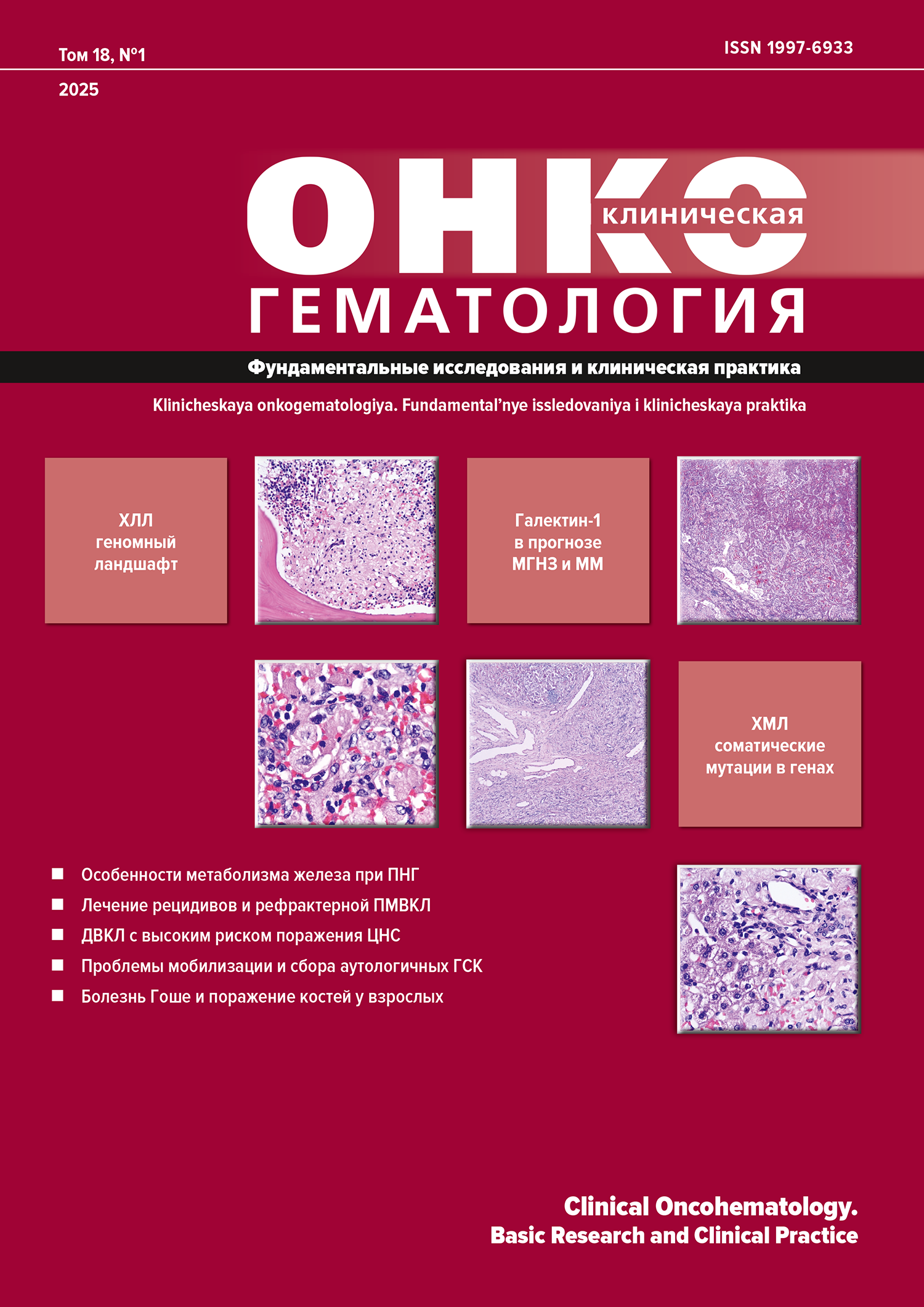Abstract
BACKGROUND. Paroxysmal nocturnal hemoglobinuria (PNH) is a rare clonal hematologic disease manifesting among others in hemolytic anemia. Due to predominantly intravascular hemolysis, iron metabolism in PNH patients is characterized by a number of features. Pathogenetic treatment with complement C5-inhibitors modifies the course of hemolysis and results in iron metabolic changes.
AIM. To characterize the serum parameters of iron metabolism in PNH patients and to evaluate T2* MRIs of the liver and kidneys.
MATERIALS & METHODS. Serum parameters of iron metabolism measured in 97 analyses and 99 T2* MRIs of the liver and kidneys were assessed in 82 PNH patients treated at the National Research Center for Hematology from 2018 to 2024. Patients were 21–76 years of age (median 39 years); there were 38 women and 44 men.
RESULTS. The analysis focused on the data from 78 PNH patients. Among non-recipients of C5-inhibitors, iron overload in liver tissue was identified in 10/38 (26.3 %) patients. In C5-inhibitor recipients, iron overload in liver tissue was found significantly more often, i.e. in 28/40 (70 %) patients. Iron overload in liver tissue was more pronounced in patients with suboptimal hematologic response to PNH therapy. A renal T2* MRI was performed in 71 patients. In all non-recipients of C5-inhibitors (n = 34), iron overload in renal tissue was detected. In C5-inhibitor recipients, iron overload in renal tissue occurred significantly less often, i.e. in 21/37 (57 %) patients.
CONCLUSION. Iron overload in renal cortex was identified in all PNH patients who were not treated with C5-inhibitors. Iron overload in liver tissue was associated with blood transfusions and suboptimal hematologic response to pathogenetic PNH therapy. In evaluating iron overload in liver and renal tissues, laboratory methods for assessing iron metabolism in PNH patients have lower sensitivity compared to T2* MRI. In PNH patients, the achievement of optimal response to C5-inhibitor treatment is associated with a decrease in severity of iron overload in renal tissue and no hepatic hemosiderosis.
References
- 1. Brodsky RA. How I treat paroxysmal nocturnal hemoglobinuria. Blood. 2021;137(10):1304–9. doi: 10.1182/blood.2019003812.
- 2. Peng G, Yang W, Jing L, et al. Iron Deficiency in Patients with Paroxysmal Nocturnal Hemoglobinuria: A Cross-Sectional Survey from a Single Institution in China. Med Sci Monit. 2018;24:7256–63. doi: 10.12659/MSM.910614.
- 3. Lukina K, Tsvetaeva N, Nikoulina O, et al. Iron Overload in Patients with Paroxysmal Nocturnal Hemoglobinuria. Blood. 2018;132(Suppl 1):1051. doi: 10.1182/blood-2018-99-114654.
- 4. Parker C. Eculizumab for paroxysmal nocturnal haemoglobinuria. Lancet. 2009;373(9665):759–67. doi: 10.1016/S0140-6736(09)60001-5.
- 5. Hillmen P, Young NS, Schubert J, et al. The Complement Inhibitor Eculizumab in Paroxysmal Nocturnal Hemoglobinuria. N Engl J Med. 2006;355(12):1233–43. doi: 10.1056/NEJMoa061648.
- 6. Risitano AM, Notaro R, Luzzatto L, et al. Paroxysmal Nocturnal Hemoglobinuria – Hemolysis before and after Eculizumab. N Engl J Med. 2010;363(23):2270–2. doi: 10.1056/NEJMc1010351.
- 7. Waheed A, Kuter DJ. Iron overload after complement inhibitor treatment of paroxysmal nocturnal hemoglobinuria. Am J Hematol. 2021;96(7):E235–E237. doi: 10.1002/ajh.26187.
- 8. Risitano AM, Imbriaco M, Marando L, et al. From perpetual haemosiderinuria to possible iron overload: iron redistribution in paroxysmal nocturnal haemoglobinuria patients on eculizumab by magnetic resonance imaging. Br J Haematol. 2012;158(3):415–8. doi: 10.1111/j.1365-2141.2012.09145.x.
- 9. Савченко В.Г., Лукина Е.А., Михайлова Е.А. и др. Клинические рекомендации по ведению больных с пароксизмальной ночной гемоглобинурией. Гематология и трансфузиология. 2022;67(3):426–39. [Savchenko V.G., Lukina E.A., Mikhaylova E.A., et al. Clinical guidelines for the management of patients with paroxysmal nocturnal hemoglobinuria. Russian Journal of Hematology and Transfusiology. 2022;67(3):426–39. doi: 10.35754/0234-5730-2022-67-3-426-439. (In Russ)]
- 10. Debureaux P-E, Kulasekararaj AG, Cacace F, et al. Categorizing hematological response to eculizumab in paroxysmal nocturnal hemoglobinuria: a multicenter real-life study. Bone Marrow Transplant. 2021;56(10):2600–2. doi: 10.1038/s41409-021-01372-0.
- 11. Латышев В.Д., Фидарова З.Т., Пономарев Р.В. и др. Оценка гематологического ответа на терапию ингибиторами С5-компонента комплемента у пациентов с пароксизмальной ночной гемоглобинурией. Онкогематология. 2024;19(1):83–91. doi: 10.17650/1818-8346-2024-19-1-83-91. [Latyshev V.D., Fidarova Z.T., Ponomarev R.V., et al. Hematological response in patients with paroxysmal nocturnal hemoglobinuria treated with C5-inhibitor. Oncohematology. 2024;19(1):83–91. doi: 10.17650/1818-8346-2024-19-1-83-91. (In Russ)]
- 12. Henninger B, Alustiza J, Garbowski M, Gandon Y. Practical guide to quantification of hepatic iron with MRI. Eur Radiol. 2020;30(1):383–93. doi: 10.1007/s00330-019-06380-9.
- 13. Git K-A, Fioravante LAB, Fernandes JL. An online open-source tool for automated quantification of liver and myocardial iron concentrations by T2* magnetic resonance imaging. Br J Radiol. 2015;88(1053):20150269. doi: 10.1259/bjr.20150269.
- 14. Кулагин А.Д., Климова О.У., Добронравов А.В. и др. Клиническая манифестация и ошибки диагностики классической пароксизмальной ночной гемоглобинурии: анализ 150 наблюдений. Клиническая онкогематология. 2017;10(3):333–41. doi: 10.21320/2500-2139-2017-10-3-333-341. [Kulagin A.D., Klimova O.U., Dobronravov A.V., et al. Clinical Manifestation and Errors in the Diagnosis of Classical Paroxysmal Nocturnal Hemoglobinuria: A case series of 150 patients. Clinical oncohematology. 2017;10(3):333–41. doi: 10.21320/2500-2139-2017-10-3-333-341. (In Russ)]
- 15. Van Straaten S, Biemond BJ, Kerkhoffs J, et al. Iron overload in patients with rare hereditary hemolytic anemia: Evidence‐based suggestion on whom and how to screen. Am J Hematol. 2018;93(11):E374–E376. doi: 10.1002/ajh.25251.
- 16. Ige AO, Ongele FA, Adele BO, et al. Pathophysiology of iron overload-induced renal injury and dysfunction: Roles of renal oxidative stress and systemic inflammatory mediators. Pathophysiology. 2019;26(2):175–80. doi: 10.1016/j.pathophys.2019.03.002.
- 17. Chen Q, Hazra R, Crosby D, et al. Heme-induced loss of renovascular endothelial protein C receptor promotes chronic kidney disease in sickle mice. Blood. 2024;144(5):552–64. doi: 10.1182/blood.2023023528.

This work is licensed under a Creative Commons Attribution-NonCommercial-ShareAlike 4.0 International License.
Copyright (c) 2025 Clinical Oncohematology

